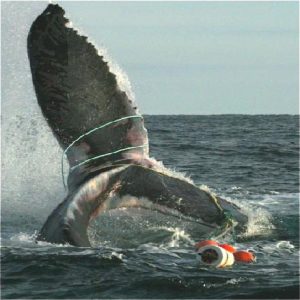Whale Entanglement
Whale Entanglement
Whale entanglement is a growing problem in terms of conservation, welfare and human safety. The full extent is hard to assess as most entanglements are never observed, but research suggests that over 300,000 whales and dolphins die annually due to entanglement in fishing gear, and others are also trapped in marine debris. This can have a devastating, long-term conservation impact on those populations which are already threatened, in some cases critically.

Man has been killing whales for millennia and with increasing effectiveness when being killed intentionally. The explosive harpoon has been a major factor in that advance. This efficient killing method has led to the near extinction of major large whale stocks in both hemispheres. Unintentional whale killings have also grown to be of substantial concern both in terms of marine mammal stock conservation and also through the way in which the animals die.
Whale Entanglement Issues
Whale entanglement is also a serious welfare issue. It can lead to drowning as trapped animals cannot reach the surface to breathe, to wound and infection as heavy ropes bite through skin, and to starvation as animals towing heavy fishing gear cannot feed effectively.

Human refuge is another very important concern. Handling any large, wild animal can be dangerous. Responding to one at sea, and that is likely to be injured and distressed, requires training and calm, careful implementation of safety protocols, minimizing risk to the response team and conducting the most effective disentanglement possible, whatever the scenario.
Unfortunately, whale entanglement is a problem around the globe, and we can only help a small percentage of entangled whales.
The effect that entanglements can have on cetaceans is a concern to the Australian Government. Most whales and dolphins are at risk from entanglements; as a result of rubbish, marine debris or marine industry activities.
Some large whale species (humpback whales and southern right whales) which make annual migrations to inshore Australian waters to breed and give birth are still making a gradual recovery from the impacts of whaling in the last century.
This recovery has coincided with a growth in coastal development, fishing activities, aquaculture and other off shore infrastructure. Much of this activity is within the migratory paths of these marine mammals. As a result there has been an increase in the reported incidence of whale entanglement in Australian waters in recent years. This issue is not confined to our region, with reports of whale entanglements on the increase throughout the world.
Whale entanglement can cause serious injury and distress to the animals and may result in the animal dying. Government agencies coordinate activities to disentangle whales whenever possible. Disentangling a whale is a very skillful exercise and can also be dangerous. For this reason disentanglement training is essential to ensure government staffs have the skills and expertise to perform this extremely important task. State governments run training courses and only trained government staff can assist in disentanglement operations.